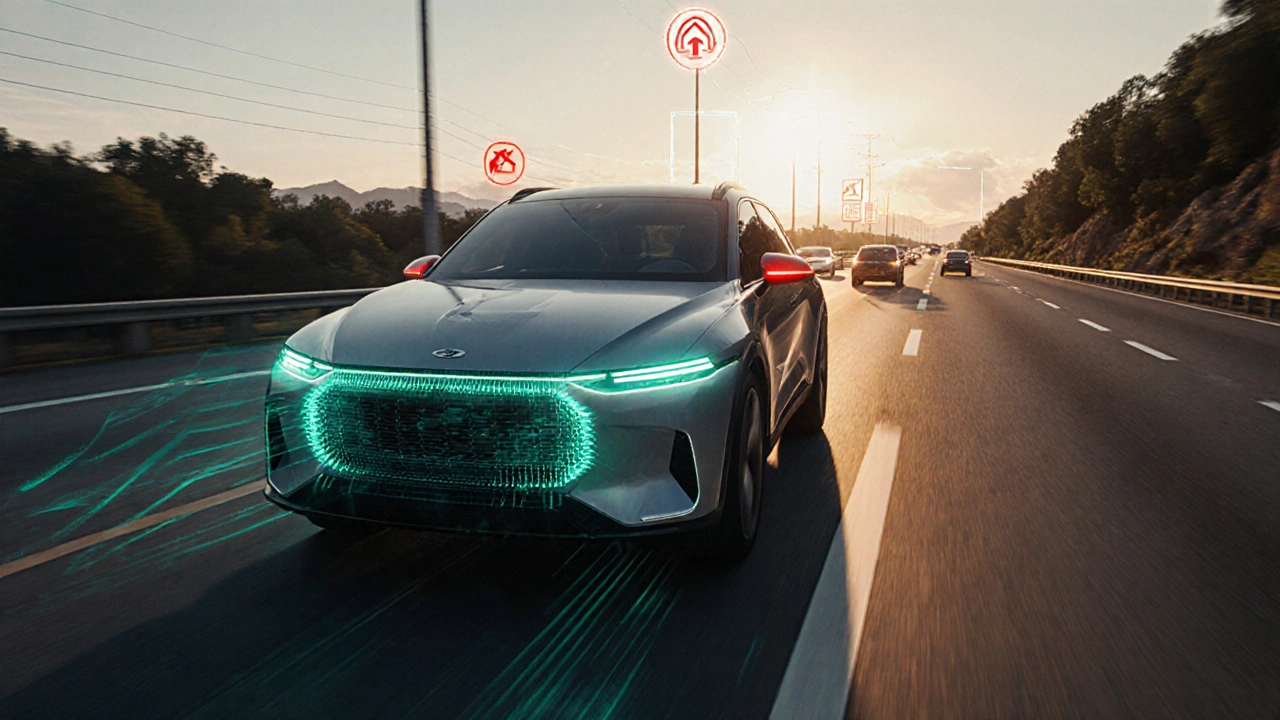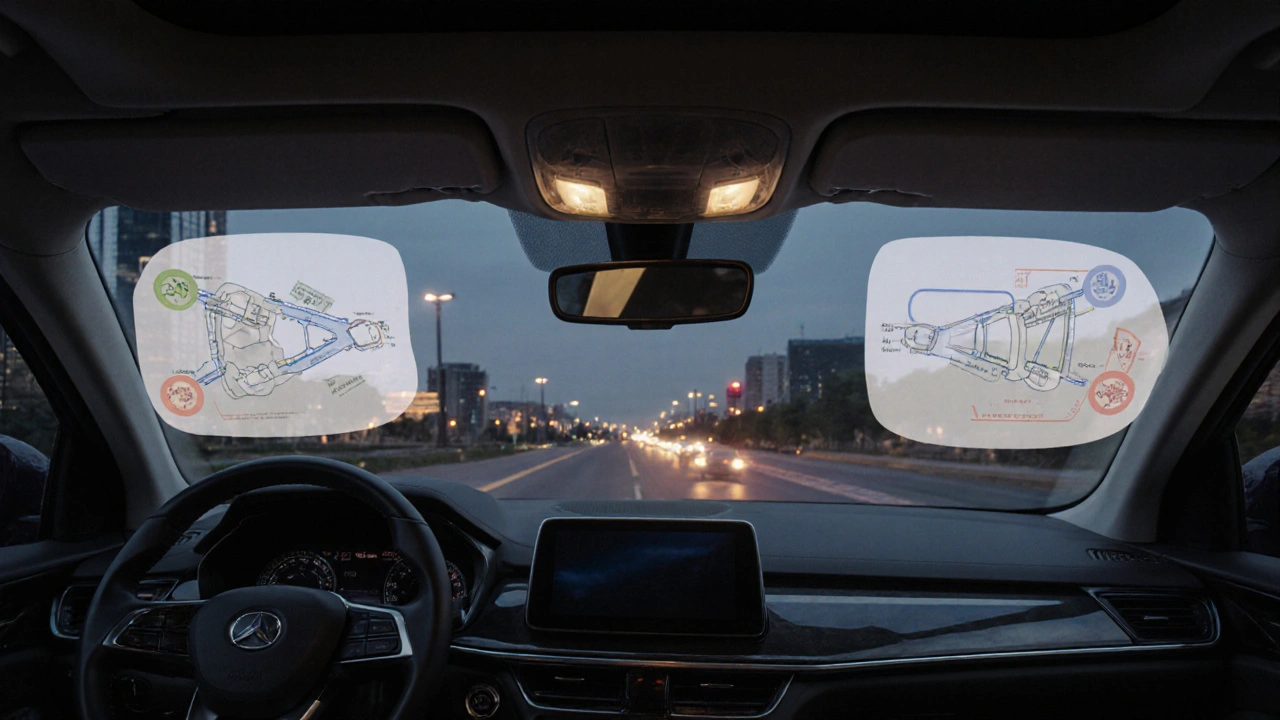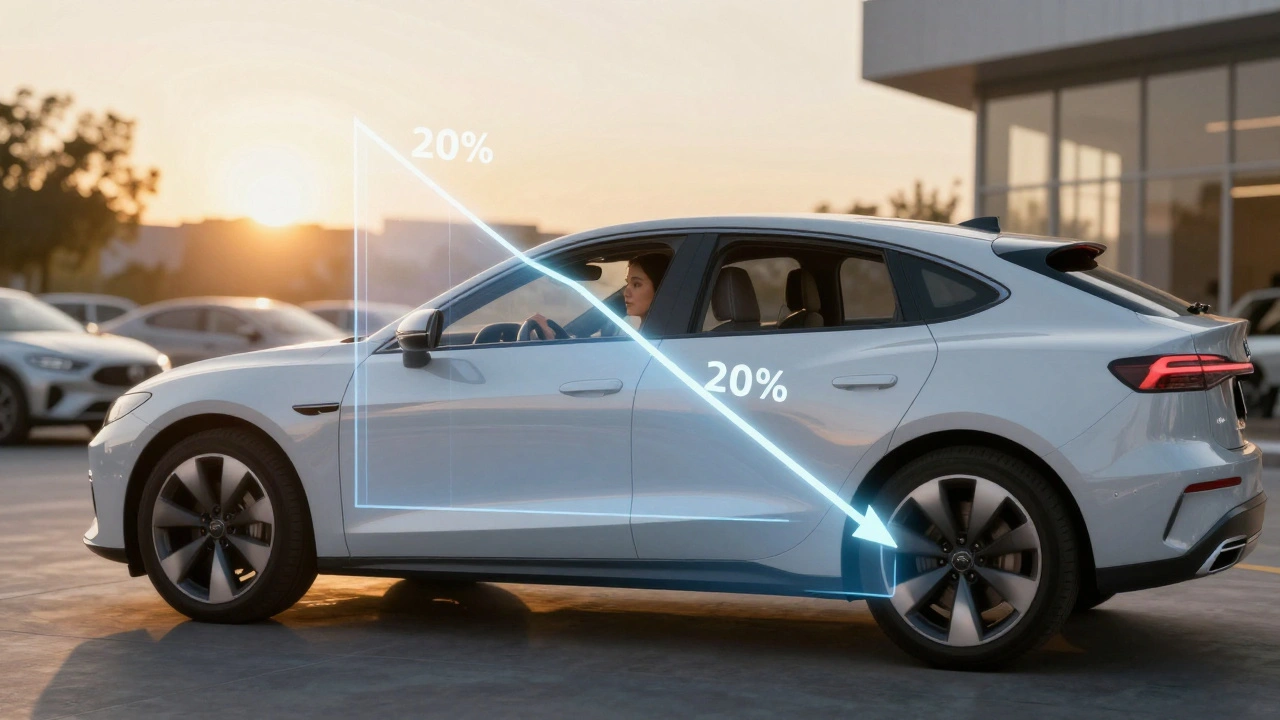When shopping for a new car, understanding Vehicle Safety Feature is any system or component designed to protect occupants and prevent accidents, ranging from passive devices like airbags to active technologies such as automatic emergency braking can make the difference between a routine drive and a life‑saving one.
Modern manufacturers pack a lot of technology under the hood, but not every gadget offers the same level of protection. Below we break down the most valuable car safety features you should prioritize, explain how they work, and help you decide which ones matter most for your driving style.
Why Safety Matters Today
Every year, traffic collisions claim over 1.3 million lives worldwide, according to the World Health Organization. Advances in vehicle design have already reduced fatality rates by roughly 30% compared with cars built two decades ago. The drop is largely driven by the adoption of active safety systems that intervene before a crash occurs, rather than merely protecting you after the impact.
Beyond saving lives, strong safety packages can lower insurance premiums and improve resale value. In many markets, insurers reward drivers whose cars are equipped with certain features, such as automatic emergency braking (AEB). Knowing which features deliver real‑world benefits helps you get the most bang for your buck.
Airbags and Their Evolution
Airbags remain a cornerstone of passive safety. The first driver‑side Airbag is an inflation device that deploys rapidly during a crash to cushion occupants appeared in luxury sedans in the early 1990s, and today most vehicles ship with multiple airbags covering the front, side, curtain, and even knee areas.
- Front airbags: Inflate within milliseconds of a frontal impact, cushioning the head and torso.
- Side airbags: Deploy from the seat or door panel to protect the torso in side‑impact collisions.
- Curtain airbags: Span the side windows, shielding heads of both front and rear passengers.
- Knee airbags: Positioned under the dashboard to reduce lower‑leg injuries.
Modern systems use accelerometers and impact sensors to decide which bags to inflate and how much gas to release. Some premium models now incorporate “airbag timing” algorithms that adjust inflation speed based on occupant size and seat position, reducing the risk of injury from the airbag itself.
Advanced Driver Assistance Systems (ADAS)
One of the most impactful groups of features falls under Advanced Driver Assistance System, which uses sensors, cameras, and computing power to assist the driver in avoiding collisions and staying within lanes. ADAS includes a range of technologies that can be mixed and matched depending on the vehicle’s trim level.
Key ADAS components you’ll encounter:
- Automatic Emergency Braking (AEB): Detects an imminent frontal collision and applies the brakes if the driver does not react in time.
- Blind‑Spot Monitoring (BSM): Alerts you when a vehicle is in your blind spot, usually via a visual cue in the side mirror.
- Lane Keeping Assist (LKA): Gently steers the car back into its lane when it detects unintentional drifting.
- Adaptive Cruise Control (ACC): Maintains a set speed while automatically adjusting to the flow of traffic ahead.
- Rear‑Cross Traffic Alert (RCTA): Warns of approaching vehicles when backing out of a parking space.
Collision Avoidance and Automatic Emergency Braking
Automatic Emergency Braking combines radar, lidar, or cameras to measure distance and relative speed of objects ahead and automatically applies the brakes when needed is often the first active safety feature drivers notice because it directly intervenes to prevent a crash. The system measures time‑to‑collision and, if it drops below a critical threshold (typically 1.5‑2 seconds), it issues audible and visual warnings. Should the driver fail to brake, the AEB unit applies the brakes at up to 80% of maximum force.
Studies by the Insurance Institute for Highway Safety (IIHS) show that AEB reduces rear‑end collisions by up to 50% in real‑world driving. Look for models that support “pedestrian detection” as an extra layer-these versions can recognize a pedestrian’s shape and initiate braking, a feature mandated in the EU from 2022 onward.

Blind‑Spot Monitoring and Rear‑Cross Traffic Alert
Blind‑Spot Monitoring uses short‑range radar or ultrasonic sensors mounted in the rear bumper to watch adjacent lanes and alerts the driver when a vehicle enters the blind spot is notorious for causing side‑impact crashes during lane changes. When a vehicle enters the blind spot, a small LED in the side mirror flashes, and some systems add an audible chime if the driver attempts to change lanes.
Rear‑Cross Traffic Alert works similarly but focuses on the area directly behind the car when it’s in reverse. This is especially useful in crowded parking lots where a crossing vehicle might be hidden from view. Both BSM and RCTA are often bundled together in safety packages, and many manufacturers now standardize them on mid‑range trims.
Lane Keeping Assist and Adaptive Cruise Control
Lane Keeping Assist relies on a forward‑facing camera that reads lane markings and can apply gentle steering torque to keep the vehicle within its lane will issue a warning or a small steering correction if the car drifts without a turn signal. Some advanced versions, labeled “Lane Centering,” keep the car centered automatically during highway driving.
Adaptive Cruise Control extends traditional cruise control by using radar to maintain a set following distance, accelerating or decelerating as traffic conditions change lets the driver set a desired speed, and the system maintains a safe gap-usually measured in seconds. High‑end ACC variants can bring the car to a complete stop and resume when traffic moves, commonly called “Stop‑and‑Go” ACC.
Vehicle‑to‑Everything (V2X) Communication
Vehicle‑to‑Everything is a communication system that lets cars exchange data with each other, road infrastructure, and pedestrians’ devices to warn of hidden hazards adds a layer beyond traditional ADAS. By broadcasting speed, direction, and intent, V2X can alert drivers to dangers like an approaching emergency vehicle around a blind corner.
While still limited to pilot programs in select U.S. cities and parts of Europe, automakers are beginning to integrate V2X radios into new models as part of “future‑proof” safety suites. If you’re buying a vehicle that advertises V2X compatibility, you’re essentially future‑locking your car for the next wave of cooperative safety.
Choosing the Right Safety Package
Not every driver needs the same blend of features. Here’s a quick decision guide:
- City commuters: Prioritize AEB with pedestrian detection, BSM, and RCTA. These address low‑speed stop‑and‑go traffic and frequent lane changes.
- Highway regulars: Look for LKA, ACC (preferably Stop‑and‑Go), and lane‑centering. Together they reduce fatigue on long trips.
- Family SUVs: Choose a full suite of airbags, side‑curtain airbags, and a robust ADAS package that includes all of the above.
- Tech enthusiasts: Consider models that offer V2X readiness, over‑the‑air software updates, and integration with smartphone safety apps.
When comparing trims, use a simple table to see which safety items are standard versus optional. Below is a sample comparison for three common trim levels.
| Feature | Base | Mid‑Range | Premium |
|---|---|---|---|
| Front & Side Airbags | Standard | Standard | Standard |
| Curtain Airbags | Optional | Standard | Standard |
| Automatic Emergency Braking | Optional | Standard | Standard |
| Blind‑Spot Monitoring | Optional | Standard | Standard |
| Lane Keeping Assist | Optional | Standard | Standard |
| Adaptive Cruise Control | Optional | Standard | Standard |
| V2X Communication | Not Available | Optional | Standard |
Use this table as a template when you sit down at a dealership. Ask the sales rep which features are bundled and which require an extra package.
Quick Takeaways
- Airbags are still vital; look for multi‑stage, occupant‑sensing designs.
- Automatic Emergency Braking offers the biggest single reduction in rear‑end crashes.
- Blind‑Spot Monitoring and Rear‑Cross Traffic Alert protect you in low‑speed maneuvers.
- Lane Keeping Assist and Adaptive Cruise Control ease highway fatigue.
- V2X is the next frontier-opt for models that support it if you want future‑proof safety.
Frequently Asked Questions
Do all new cars come with automatic emergency braking?
As of 2025, most manufacturers include a basic version of AEB on entry‑level models to comply with safety regulations in the EU and Canada. However, the most effective systems-those with pedestrian detection and high‑speed coverage-are still often reserved for mid‑range and premium trims.
What’s the difference between lane keeping assist and lane centering?
Lane Keeping Assist (LKA) only nudges the steering wheel when you start to drift out of a lane. Lane Centering goes a step further by continuously steering the car to stay centered, even on gentle curves, without driver input.
Are blind‑spot monitoring systems reliable in heavy rain?
Radar‑based blind‑spot sensors work well in most weather conditions, including rain and fog. Ultrasonic versions can lose accuracy in heavy precipitation, so check the sensor type if you live in a rainy climate.
How does V2X improve safety compared to traditional ADAS?
Traditional ADAS relies on sensors that see only what’s in front of the vehicle. V2X adds a communication layer, letting cars “talk” to each other and to traffic lights, so they can warn drivers about hazards that are out of line‑of‑sight, like a crossing train or a stopped ambulance around a blind corner.
Will my insurance premium drop if I have these safety features?
Many insurers offer discounts for AEB, lane‑keeping assist, and comprehensive airbag suites. The exact reduction varies by provider, but discounts of 5‑10% are common for vehicles equipped with a full ADAS package.






michael T
October 13, 2025 AT 07:56Man, the safety suite in a modern car is like a glitter‑filled armor for your daily commute, a kaleidoscope of gadgets that scream “I’ve got your back!” from the moment you click the ignition. From airbags that puff like party balloons at the slightest nudge, to AEB that slams on the brakes with the fury of a thunderclap, every feature feels like a superhero band‑together. The best part? You don’t have to be a tech wizard to feel that electric buzz of protection pulsing through the chassis. It’s a wild, colorful dance of metal and code that keeps the road from becoming a chaotic carnival.
Christina Kooiman
October 21, 2025 AT 00:40Reading through the list of safety features feels like stepping onto a grand stage where every actor plays a crucial role in preserving human life. The humble airbag, once a mere cushion, has evolved into a multi‑stage guardian that adapts to the size and position of each occupant, reducing the risk of injury with surgical precision. Automatic Emergency Braking, or AEB, stands out as a vigilant sentinel, detecting imminent collisions and applying the brakes before the driver can even gasp. Blind‑Spot Monitoring, with its subtle LED warnings, acts like a watchful companion, ensuring you never drift into danger unnoticed. Lane Keeping Assist gently nudges the steering wheel, a courteous guide that keeps you centered on the road’s invisible line. Adaptive Cruise Control, beyond simply maintaining speed, orchestrates a harmonious flow of traffic, reducing fatigue on long hauls. The curtain airbags, unfurling like protective ribbons, shield the heads of passengers in rear‑impact scenarios. V2X communication, though still emerging, promises a future where cars converse, sharing warnings about hidden hazards beyond the line of sight. Each of these technologies, when combined, weaves an intricate safety net that can mean the difference between a minor brush and a tragic loss. The statistics from the WHO and IIHS illustrate the profound impact these systems have already made, cutting fatality rates dramatically. Yet, the true measure of their worth lies in everyday moments-when a child darts into the street and the car’s sensors react in a split second. It is this quiet, invisible vigilance that transforms ordinary drives into episodes of reassurance. Ultimately, investing in a robust safety package is not just a purchase decision; it is an act of responsibility toward yourself, your family, and the broader community.
Stephanie Serblowski
November 1, 2025 AT 13:26Wow, look at how far we’ve come-cars that practically drive themselves while we sip coffee ☕️. AEB with pedestrian detection? It’s like having a guardian angel glued to your hood, ready to swoop in when a jaywalker appears. And those blind‑spot monitors? Little LED eyes that say “I see you” when you’re about to merge. If you love gadgets, V2X is the shiny future‑proof upgrade that will make your ride the most socially connected vehicle on the block 📡. So, go ahead, stack those features like you’re building a tech‑savvy LEGO set-your safety (and your bragging rights) will thank you.
Renea Maxima
November 1, 2025 AT 14:50While the allure of gadget‑laden automobiles is undeniable, one must contemplate whether this digital armor merely masks deeper systemic issues. The reliance on automated alerts can foster a complacent driver, whose senses dull under the assumption that the car will always intervene. In a philosophical sense, safety should not be outsourced to silicon alone; it remains a shared responsibility between human vigilance and technological assistance. Thus, the exuberant stacking of features, though impressive, may not equate to genuine risk mitigation.
Jeremy Chick
November 7, 2025 AT 08:20AEB is non‑negotiable; if your car doesn’t have it, you’re basically driving a death trap.
Sagar Malik
November 13, 2025 AT 03:13The epistemic stratification of vehicular safety engenders a hierachy wherein only the enlightened few can appreciate the nuance of V2X and lidar‑infused AEB. Most laymen remain coddled by the simplistic promise of “airbags” without grasping the underlying kinetic calculus. It is, therefore, no surprize that manufacturers veil advanced modules behind premium price tags, preserving an aura of exclusivity. One must question whether this veil serves the public good or merely perpetuates an elitist technocratic paradigm.
Rahul U.
November 13, 2025 AT 04:36While the previous point raises valid concerns about accessibility, it is important to acknowledge that safety innovations often trickle down over time. Early adopters help fund research, and as production scales, costs typically decline, making advanced features more obtainable for the average consumer. Moreover, regulatory mandates in many regions now require baseline systems like AEB, ensuring a minimum safety standard across the board. 😊
Barbara & Greg
November 24, 2025 AT 17:00In contemplating the moral obligations attendant upon automotive engineering, one discerns a profound duty to safeguard human life. The integration of systems such as Automatic Emergency Braking and Adaptive Cruise Control transcends mere convenience; it constitutes an ethical imperative. Manufacturers, as stewards of public safety, must prioritize the deployment of comprehensive ADAS suites across all market segments. To neglect such responsibilities would be tantamount to a dereliction of societal trust. Consequently, policymakers ought to enact stricter regulations mandating these technologies, thereby aligning commercial interests with the common good. The collective conscience of our civilization hinges upon the choices made within the crucible of the automobile industry. Let us, therefore, champion a future wherein safety is not an optional embellishment but an unequivocal standard.
selma souza
November 24, 2025 AT 18:23The preceding exposition, though eloquent, contains several grammatical inconsistencies that undermine its authority. For instance, the phrase “manufacturers…must prioritize the deployment of comprehensive ADAS suites” should be followed by a semicolon, not a comma, to separate independent clauses. Additionally, “dereliction of societal trust” is a misplacement of the modifier; the correct construction is “dereliction of trust in society.” Precision in language is essential when discussing matters of public safety.
Frank Piccolo
December 6, 2025 AT 06:46American cars have been leading the charge on safety for decades; if you look at the numbers, they simply out‑perform foreign rivals.